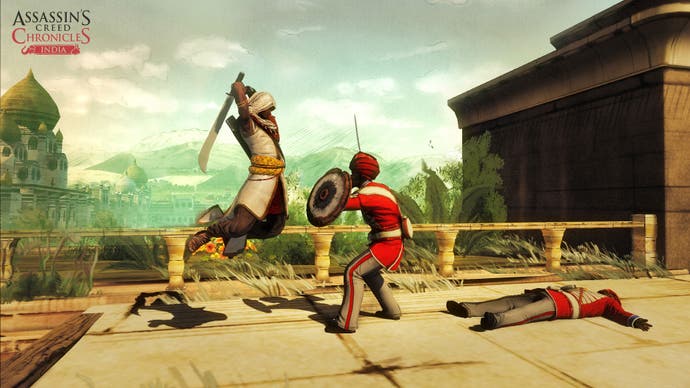Assassin's Creed Chronicles: India is a spin-off taking risks and finding its feet
Creed-only memory.
Editor's note: This is an impressions piece on Assassin's Creed Chronicles: India, the second of a three part series. In accordance with our review policy, we'll be posting a full review once all episodes are out.
Surely the most enjoyable aspect for anyone working on the Assassin's Creed series, Ubisoft's time-travelling murder tourism franchise, is imagining to what era and continent the series should travel next. Every history book offers a host of alluring options: feudal Japan, gangster-land Chicago, Soviet Russia. It's fun to imagine how the series' characteristics of quasi-historical spy-craft and weaponised parkour might translate to the architecture and culture of any particular time and place.
Turning the thought into a commercial product is another thing entirely, however. Assassin's Creed games might arrive with reliable and wearying regularity but they are costly mass productions and must, therefore, favour only popular destinations: Renaissance Italy, Ripper-era London and so on. Chronicles, an emerging trilogy of digital spin-offs, of which this is the second entry following 2015's sojourn to 16th century China, are more modestly produced and priced affairs that therefore offer the chance to visit some less worn points in time and space. So here we arrive at Amritsar in Northern India in the 1840s, where the British-run East India company is at war with the Sikh Empire, a skirmish that presents an opportunity for Arbaaz Mir, assassin and diamond thief.
At a time when the art direction of many mainstream video games continues to favour the dour and drab, Chronicles India offers a Pantone-spill of vibrant colour. As you step out onto a rampart at the start of each level, crimson-feathered birds take off against a horizon of minarets, peach and purple in sundown. India provides more than mere inspiration for the palette. Rather than take refuge in carts of hay, Arbaaz can dive into piles of bright flowers and spice. Henna-esque cogs and patterns sit over the environment as subtle overlays or environmental detail (intricate twirls of light penned from the tips of open flames, for example) while a guitarist plays a raga, accompanied by a patter of tabla and other Indian percussion. The art direction, particularly in those outdoors areas of the game, near the Pakistan border, is exquisite and, crucially, the choice of location is broadly unfamiliar in games, a reminder of how few venture beyond a handful of popular cities.

The game follows Chronicles: China's side-scrolling template, tweaking the formula to match the historical setting, while adding a number of improving inventions and additions. The game's earliest stages are stealth missions. You must work your way past a variety of guards, using flowerbeds, pillars and darkened doorways for cover, pickpocketing crucial keys and items, and navigating your way around the buildings, most of which are dressed with route-facilitating planks, beams and poles. The expanding variety of guards behave in different ways, the reach of their vision is indicated by on-screen cones and markers. There's a sense of elation when, for example, you pick the lock to a door and slip through, avoiding a patrolling guard's vision cone indicator by millimetres. As well as being able to use smoke bombs to blind enemies, and tinkling darts to distract their attention, in Chronicles: India you also have the use of Chakram, a projectile that can be bounced off walls like a beam of light off a mirror, either to cut the cords holding bells in order to cause a distraction, or to knock away fragile beams in order to create new pathways.
Most levels are broken into sections. You're awarded a grading based on your efficiency at clearing each area, according to three approaches: 'Shadow', in which you progress without leaving any trace of having been there, 'Silencer', in which you put guards to sleep with a chokehold without raising the alarm, and 'Assassin', where you silently kill those who stand in your way. While the design allows you to choose your preferred approach, the rewards are stacked toward those who aim for the non-lethal, silent approach, which often requires a great deal of trial, error and restarts, as you learn guards' routes, obstacles and the layout of the environment. It can, at times, become somewhat laborious for the perfectionist player.
Just as the design starts to become over-familiar it switches pace. Now you're racing through an underground network of caves against the clock. As a palate-cleanser, the approach works effectively while the more intricate, plane-switching level design improves upon Chronicles: China's equivalent section. So too do the extra-curricular activities on offer, a series of well-designed challenge rooms, outside of the main storyline, which, like Metal Gear Solid's VR missions, present score-attack variations on the core design, stripped of narrative context (as in Kojima's game, these take place in a abstract space). Here you might need to collect the animus shards as quickly as possible, or identify and assassinate a target without alerting any of the other guards in the stage.
From the vibrant art style to the more accomplished level design, Chronicles: India is an improvement on British studio Climax's first outing. The switches between speed-runner and pensive puzzler are more elegant and developed, and therefore feel less like jarring lunges. As with all things Assassin's Creed, the hum of corporate franchising is ever-present; this inevitably feels like a game designed from the IP up. There is, nevertheless, artistry here and, beyond that, further evidence of Assassins' Creed's enviable flexibility in its application across human history.

